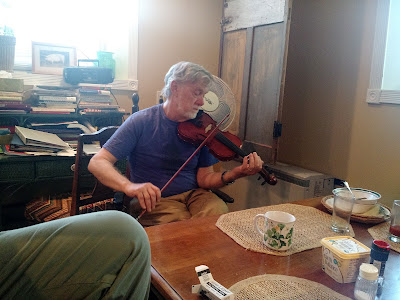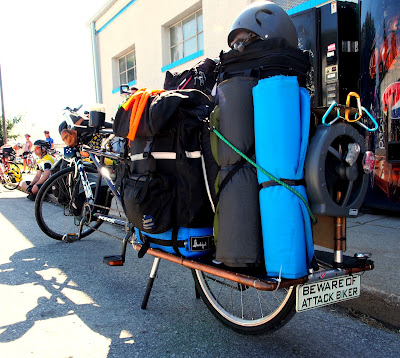Since I am currently in graduate school, we are down to taking one or two bike tours a year. When we return from our travels, we must face the concrete jungle that is Denton, Texas. This year, I'm lucky enough to bike Neva to school, and enjoy 25 miles of biking throughout the day. In going back and forth between touring and commuting, I've noticed a few pieces of gear that work great for both purposes,and in all seasons. There are things like bike lights, a helmet, a pump and patch kit, etc. that are a given every time you ride, but this list is of the not-so-obvious must-haves for the chronic cyclist.
1. The Buff
- The Buff is ingenious in its simplicity. At first glance, it looks like just a stretch tube of fabric; not very exciting, but after using this product over many miles, the usefulness shines through.
For both on tour and commuting, the Buff can act as a balaclava to protect your face from the cold. On hot days, if you're touring in the desert, your mouth is protected from sand from the prevalent dirt devils of a vast and arid climate. When commuting in Texas, every morning on the bike path and around sidewalks, leaf/sand/pine needle cleanup uses blowers and weed wackers to keep the sidewalks looking nice (I guess?). Covering up with a Buff is just the thing to keep unexpected gnats, cold, dust, etc. out of your mouth. There are many other ways to wear the Buff to keep your hair out of your face as well, but for me, having quick access to an instant mouth barrier provides the most useful service.
 |
| Neva used the Buff as a head scarf when commuting by subway in NYC. |
2. Da Brim
- Simplicity will be a common theme with the products I use most regularly. Da Brim is a circle of fabric that velcro tightens around your helmet, giving shade that is equivalent to wearing a 10-gallon hat.
 |
| Neva and I are sporting da Brim look. Neva's is handmade by me, and mine is the $50 version available only online. |
Da Brim is not much more glamorous than an umbrella hat, but I got tons of compliments from people on RAGBRAI, and biking on the bike path during the Texas summer, because it looks smart. The level of protection goes all the way around, protecting your face and the back of your neck. For anyone that wears glasses, this hat addition is also helpful when it rains. The only downfall of this piece of gear is when it's really windy. Sometimes, if the wind catches da Brim just right, the whole helmet will come up. This is sometimes the case if you have a small head (like me) and your helmet just barely fits, or if you just shaved your head and now your helmet fits a little bit larger. Usually adjusting your helmet to fit properly will address this issue.
 |
| Neva's brim is still a work in progress, but with about $2 invested in the above recycled materials, we've had fun experimenting. |
3. A Bell
- Ding ding. The universal cyclist communication mechanism.
A bell might not seem that important, but if you're ever on a shared bike path, you will notice that EVERYONE, runners, bikers, walkers, etc., wear earbuds and are listening to music. You can scream, "on your left" all day, and on the off-chance they hear you, they will just wonder why you're screaming at them. It's better to just have a bell to try and warn them of your presence. If no reaction, just try to go around them as safely as possible.
Off-road or on tour the bell can come in handy for a few reasons. If you're in the wilderness, sometimes it's good to have a bell just to alert the animals of your presence, if your clunky load isn't already scaring off everything in a 2 mile radius. If you're on the open road, it's a good way to say "hello!" to the elusive other-cycle tourist. Maybe they'll even stop to chat and you have made a new best friend. Good communication is key in any relationship. Since we share the roads with everyone, the bell is the least threatening way to say, "hey, I'm here".
4. Super Collapsible Backpack
- An extra bag that is so lightweight and collapsible, that you don't even remember it's there until you need it, and then you're glad it's there.
 |
| Collapsed version |
 |
| Open bag, with tiny attached mini bag sewed to the inside. |
 |
| In use for holding snacks and necessities when on a bus in Costa Rica. All the other gear is stuffed under the bus. Oh look, the Buff made a second appearance! |
5. Pockets...Anywhere
-I'm not picky, pockets on your back, on your shorts, on your shoulder, wherever, I just want some pockets.
Mostly, this comes in really handy so that you can put your phone within hearing range when you're biking around a city, trying to find a place you've never been. The most handy that I've found is the velcro breast pocket found on adventure style shirts.
Some ladies might find it uncomfortable to put anything in the breast pocket, and that's when cycling pockets come in handy, or a sleeve pocket/phone holder. Short/pants pockets can work, but you can't quite hear directions as well if you're in a high traffic situation. You of course can put anything in your pockets that you wish (Neva likes rocks, leaves, etc.) but I have found phone directions are the most useful.
Give yourself a high five, just for being awesome, and let us know any necessities you like to always have handy when biking. My next post I'll discuss an in depth list of my first aid kit, and when some of my odd choices can come in handy.

















































